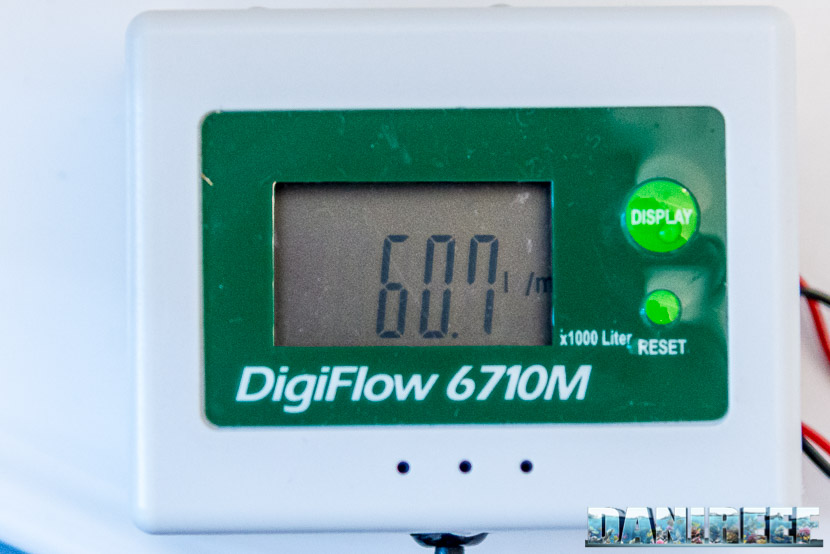Hydraulic head test
The first test we did concerned the hydraulic head. As you may know the hydraulic head is the pump’s capacity to raise the water over a certain level. In order to do this test we measured the lavel of water reached inside the rubber tube.
The following picture is from our archive to show you how we work.
As usual, we turned on the pump, we waited about 10 minutes that the pump stabilized and then we did the misuration for six times.

We have measured a maximun head of 4,50 meters versus the declared 4,2 meters.
The gap between the hydraulic head declared and measured is +7%. A very good result. The curve we recreated is quite linear.
Flow rate test
Testing the flow rate was easy thanks to the flow rate meter DigiSavant DIGIFLOW 6710M. First thing we did was connecting the tubes to our meter. We tryed to make the meter perfectly join the exit of the pump. The measurement is expressed in liters/minute, so we just had to multiply the result by 60 to obtain liters per hour.
Obviously, remember that this measurement is valid for the conditions in which we did our tests. The connecting tube could have introduced some losses in the system.
We measured the flow rate for each step of power in order to have a complete distibution of the flow rate.
These number, traduced in liters per hour lead us to the following chart:

The maximum flow rate head was 4.194 l/h (that is 69,9 l/m*60), well below the declared 6.000 l/h. So the pump reached the 70% of the declared value, in our test’s conditions. A little too low for what we were expecting, but if you go to see our other reviews, the pumps that respected the declared values for the flow rate are very few. Considering this, we can say that this 70% is just below average, and we even tried pumps with flow rate less than 50% of declared…
When you use a return pump be careful to the aspects that may lower the flow rate, even drastically. Use the larger hose supplied. Use a sufficiently large tube. The tube should always be as short as possible and avoide 90° curves. Otherwise the flow rate will highly decrease.
Distinctive curve
The distinctive curve is that specific curve that links the various values of flow rate and hydraulic head. You can’t do this without the proper equipment. We could have done this for the 6 steps we measured, but we believe that the only qualitative comparison would be enough. We only linked the two ends of flow rate and hydraulic head, both the measured and the designed ones.

Now you can see how the difference between the declared value (the top curve) and the measurement is practically negligible. As you can see on the left, the difference is larger for the flow rate than the hydraulic head. The area between the two lines is what we didn’t have but we expected given the project. Obviously the project curve is the top one. On the right, where there’s the hydraulic head, we have the opposite.
In theory, if you put yourself at the hydraulic head value you need, for example 200 cm, you should draw a line at the value of 200, see where this line crosses the distinctive line and read the corresponding flow rate value. With the Hydor Seltz D6000 at 200 cm of hydraulic head you should have a flow rate of about 2.400 l/h against the declared 3.200. In aquarium the situation will be even worse because you have to add even the friction of the tube and the curves.
In order to calculate the flow rate of your aquarium here’s a useful link with calculator integrated: automatic calculus of the return pump (italian).
Energy consumption test
The collection of data about the consumption has been made possible by the useful device RCE PM600. The result is already given in watt.

The maximum declared consumption of the Seltz is 53 watt. According to our measurements the consumption is about 12% below the declared value. A difference that comes to our advantage.
Considering a consumption of 53 watt, and a cost of 0,27 euro per kwh, we could use this pump continuously for a whole year, at its maximum with a consumption of 464 kwh, having a cost of 125 euro per year, or 10,4 euro per month.
Given the dimensions of the pump and especially its flow rate level, we couldn’t do our noise test. We can affirm that the pump is very silent, also because we’re currently using it in aquarium and otherwise we would have noticed it. But at its maximum the sound is rather acute, even if I only hear that when the door is open.
On page three you will find our final evaluation of the pump
























